Type 64
 ROCA c50 light tanks converted 1975-81.
ROCA c50 light tanks converted 1975-81.
Genesis

The Type 64 (TL64 or 六四式) as a designation, applied to two distinct Cold War light tank projects undertaken since 1975 by the Republic of China Armed Forces, a M42 Duster/M18 Hellcat hybrid and an improved copy of the M41 Walker Bulldog. Both were to serve as cavalry tanks to complement US-provided M41 light tanks and support the M48 Patton and its upgraded variant in ROCA service. The one seen here is the Hybrid one. The Taiwanese M41D would be the object of a latter article.
The original Type 64 hybrid tank project was born from the decision by the government to make due to with the lack of spares and maintenance issues with its existing park. When two models of different types were no longer operational, it still could be possible to mate a working turret with a working chassis. Also, since now they were surplus in the US, construction of tanks made from parts of dismantled American tanks provided by the United States was also possible.
The most famous of these was the Type 64 (not from the initial design date), and it was essentially a M42 Duster hull mated with an M18 Hellcat turret, and stock 3-in (76mm) tank gun. There was indeed a park of worn out M18s decommissioned supplied to the ROC Armed Forces during the Chinese Civil War, or later. The turrets were still operational, and were simply removed from the chassis. On the other hand, the US also passed on hulls of turretless surplus M42 hulls as ordered by the Government after their existence was known, shipped to Taiwan as well in the 1950s.
From this, the government was able to modify the chassis to hold the M18 turrets, and started with 14 pre-production Type 64 conversions presumably in 1975), after after the usual field tests, gunnery trials, some modifications and rework, an a full conversion batch was ordered to the Taiwanese 201 Factory with a completion likely in 1977 or 1978. The Type 64 had only circa more 11-12 built before the project was officially cancelled. In between indeed, the US provided far better surplus M48/M60s. Taiwan then put some effort into upgrading these. Thus, the Type 64 were relegated to training or reserve, and were all officially retired as of 2023. This is a fairly rare model for which little information is available.
Design in detail
M42 Chassis (mod)
The Type 64 reuses a turretless M42 Duster hull and therefore everything on the latter comes to mind:-The M42 chassis is significantly different from the M41 also they shared many common parts.
-All welded steel (RHA) hull, 9 to 25 mm front (0.35-1 in)
-Low angle front nose plate with transmission acces hatch
-Driver located at the front, central fighting compartment with M42 turret ring, larger than M41.
-Rear engine compartment, 500 hp, 6-cylinder, Continental air-cooled AOS 895-3 6-cylinder gasoline 500 hp (373 kW) (same as M41)*.
-Cross-drive, 2-speed Allison transmission.
-Drivetrain, forward idlers, rear drive sprockets, five torsion bars/schock absorbers ensemble and dampers forward.
-Six double rubberized roadwheels for single pin tracks, three return rollers.
-Top speed 72 kph (original 45 mph on flat and 100 miles (170 km) range)
*Lycoming AOSI-895-5 engine for the A1, but it's unlikely they were purchased by Taiwan.
The main specific changes to the type was that Compartments over the track guards for spare Bofors gun barrels were replaced with storage boxes of the stock M41 tank, hence the hybrid chassis.
M18 Turret
As for the M18 Turret, it was stock, no apparent change was made. It was caracterised by the following:-Elliptic open top turret with limited protection: Gun shield .75 inch (1.9 cm) from 0-60 degrees. -Turret front cast section 1 inch (2.5 cm) 23 degrees
-Turret sides .5 inch (1.3 cm) 20 degrees
-Main armament 76 mm (3 in) M1A1, M1A1C or M1A2 with 45 rounds
-52 caliber 1,141 lb (517.55 kg) gun
-Best round APCR 3400 fps.
-Performances 360 manual/hydraulic traverse 24°/sec, elevation -10 to +20°.
-Secondary armament .50 (12.7 in) M2HB machine gun, ring mount (800 rounds), but no photos shows it.
Type 64 specifications | |
| Dimensions (height unknown) | 5.82 x 3.23 m (19 ft 1 in x 10 ft 7 in) |
| Total weight, | 25 tons |
| Crew | 4 (Cdr, Driver, Gunner, Loader) |
| Propulsion | Continental AOS 895-3 6-cylinder gasoline 500 hp (373 kW) |
| Suspension | Torsion bar |
| Top speed | 72km/h |
| Range | Unknown |
| Armament | 76mm gun, 7.62mm coax LMG, .50 M2HB roof |
| Armor | 9–76 mm (0.35 to 3-in) |
| Total production | c50 |
General assessment
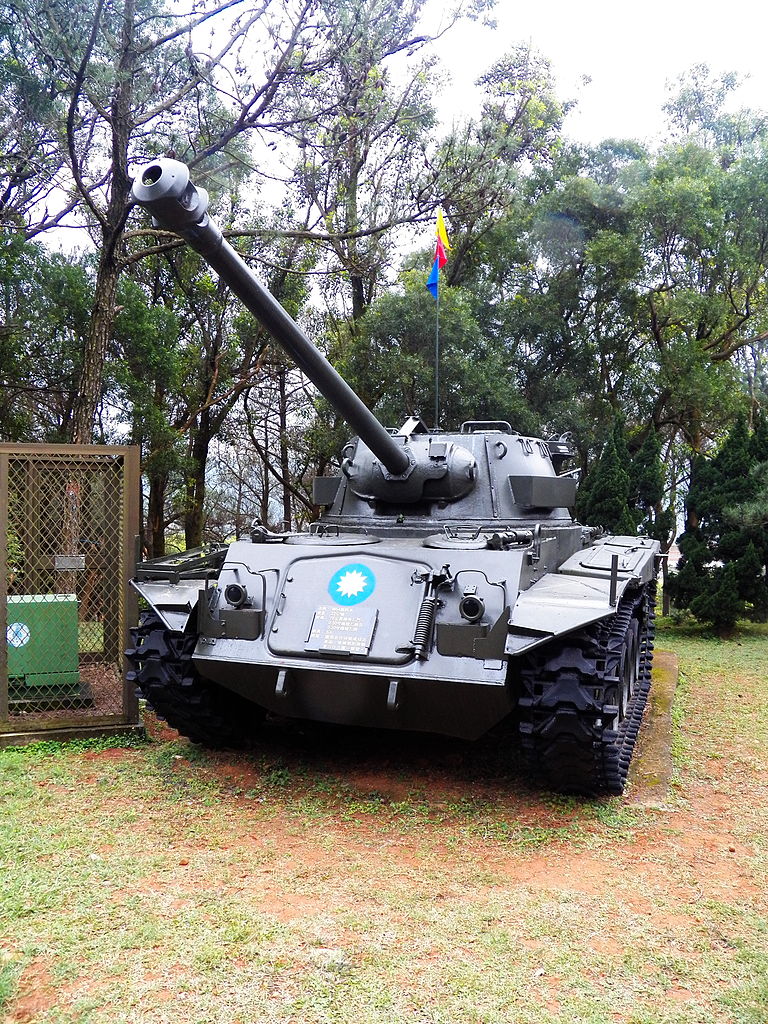
Taiwan shared with Israel the temperamental support policy changes and embargoes of the US Government over the early years of its existence, notably due to the 1960s hard-nose repression and lack of democracy in the country. It's existence also was less than assured. So it made due with whatever could be purchase, WW2 stock tanks being part of these, and the M18 Hellcat being one of the most capable tank hunter of the 1940s, very fast (sacrificing protection to speed) with a powerful but now aging M1 gun in 1948. The knowlege of surplus M42 Duster hulls (not used as the production swapped to the M42A1) led to a purchase made easier by the fact they were unarmed. Thanks to this shortcut, the M18 turret, still in good condition could be in the 1960s mated to the brand new M42 hull, compatible as maintenance was concerned with the newly acquired M41 ligh tank in the Taiwanes inventory.
At the time in 1975 it seems a good way to not waste a force worth of a batallion of tanks. The problem however which led to the conversion being stopped in 1979. It's not clear if it was for the lack of suitable turrets or chassis, but most probably the latter as the ROCA obtained 214 M18 Hellcats back in 1946-47. It is unsure of what these surplus turrets became. One way would have to fit them on concrete positions along the coast, like the "panzerturm" of WW2.
The problem however of the Type 64 was that its gun was now quite old, and despite stockpiles of suitable rounds had been delivered, it was still relately adequate against T-34/85s but no match for the Chinese Type 54s and later in 1975, the menagerie of derived Chinese MBTs, namely the and Type 69 just introduced. The latter indeed had a Sloped glacis and turret front worth 180 mm RHA and a very potent 100 mm gun firing HEAT rounds on paper-thin Type 64s. The tactic probably looked for was the same used by US crews in 1944-45 Germany against much better protected by slower Panzer V, VI Tiger I and II. Using their speed to out-manoeuver the PLA Chinese tanks and fire at the side and back, on their only weak points. A M42 could indeed run at 72 kph, whereas a Type 59 was limited to 50 km/h (28 mph) on flat, and the low topless turret wgave them an even lower profile than the original M41.
In the end, it's not even sure the c50 so converted were ever pressed into a coherent unit. Indeed, Taiwan soon obtained the M48A3 (450 converted as CM-11), and 100 M48A5 (converted as CM-12). if the project was officially cancelled in 1981 it's likely that these were parked as a reserve afterwards as no photo around the web shows these in manoeuvers. Their official retirement in 2022 is amazing given the age of the platform, if not for their WW2 stock (so 75 years old) turrets, the chassis obtained were still 50 years old.
The other Type 64, M41T prototype
The Type 64 Prototype was a locally upgraded version of the M41 Walker Bulldog. It offered the following:-Improved fire controls -530 horsepower Napco 8V-71T diesel engine -ANVRC-7 radio -New T57 7.62mm GPMG LMG -Extra applique turret armor -Sideskirts with also with cast high-hardness tungsten alloy steel. Like the other hybrid its developement year started at year Minguo 64 (1975).
It was a way to radically upgrade the now venerable M41 like tanks, of which 50 were transferred. The basic tank was reasonably capable against the Type 59 and T-55A encountered during the Vietnam War. In 1975, the new proposed upgrade would have improved electrical system, high-strength alloy steel with advanced welding techniques and the all-cast turret was reworked to better suit the shorter stature of local tank crews. An additional layer of laminated high-strength alloy steel armour plate was welded and bolted on agains front-fired HEAT and APDS projectiles.
The new 76mm rifled gun was locally manufactured as was the 7.62mm co-axial machine-gun and the improved fire control system. Modifications were made to store the ammunition as for the M41A2 and M41A3. If 14 pre-production tanks and 25 first-series tanks were ordered at the 201 Factory, last tank completed in 1979 but they were later further modified to include laser rangefinders, ballistic computers and passive night vision equipment developed by the National Sun Yat-Sen Research Institute.
This led to the M41D standard: New Detroit Diesel 8V-71T diesel (72 km/h/45 mph, range 450 km/280 mi) new turret M32K1, new co-axial Type 74 (FN MAG), new fume extractor and different muzzle brake, and thermal imaging sights. We will go back to this standard later.
Links/sources
Type 64 on army-guideThe Type 64 hybrid - for the record
The other Type 64 prototype - for the record
catainium.blogspot.com
Ding Hao model kit
Same on scalemates
Wikipedia

Regular Type 64 as built. They only sported a small nationalist sun star.
Gallery

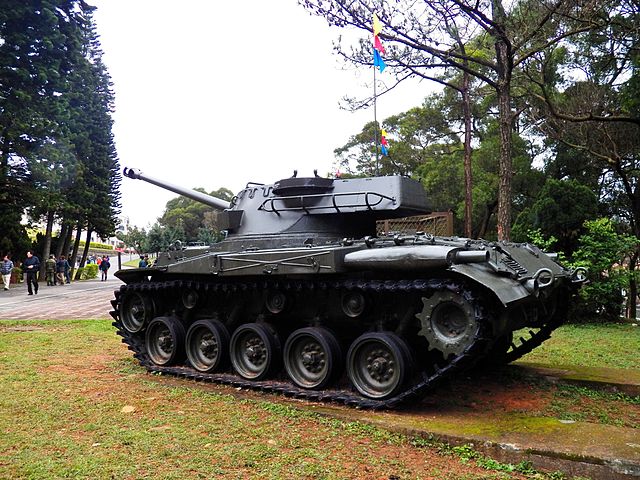
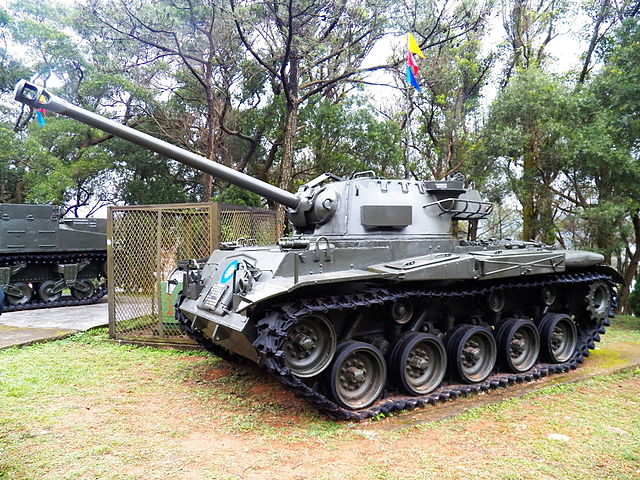
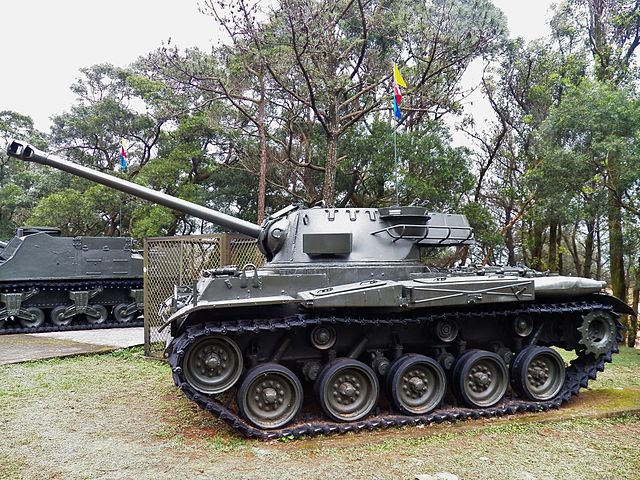
Type 64 on Display at Tanks Park Armor School
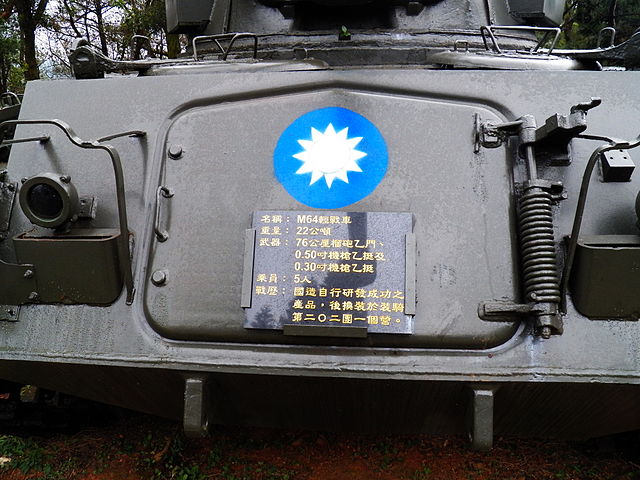
Plaque on the front glacis door

Cold War Tanks


































Cold war tanks posters

Cold War Main Battle Tanks

Cold War Soviet Army
Museums, Movies, Books & Games
The Tanks and Armor in pop culture
Tanks and armored vehicles in general are only really grasped when seen first person: The mass, the scale, it's all there. Explore also the way tanks were covered in the movie industry, in books and in video games.Movies:
Best tanks movie on warhistoryonline.com
On imdb.com
On bestsimilar.com/
miltours.com
liveabout.com/
watchmojo.com
Video Games:
pcgamesn.com
historyhit.com
levvvel.com
vg247.com/best-tank-games
mmobomb.com/
alienwarearena.com
